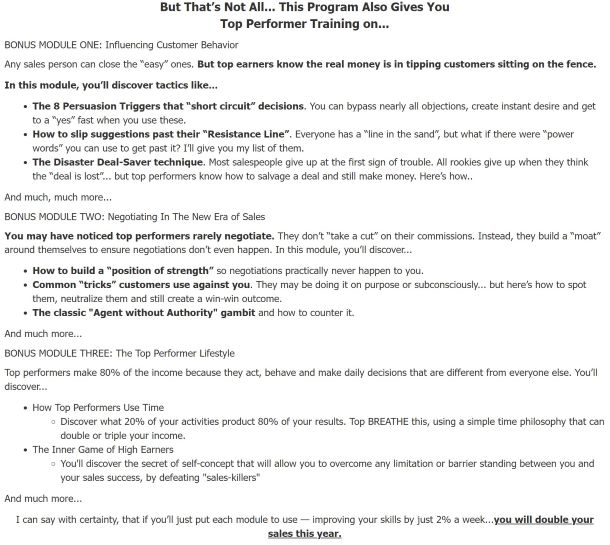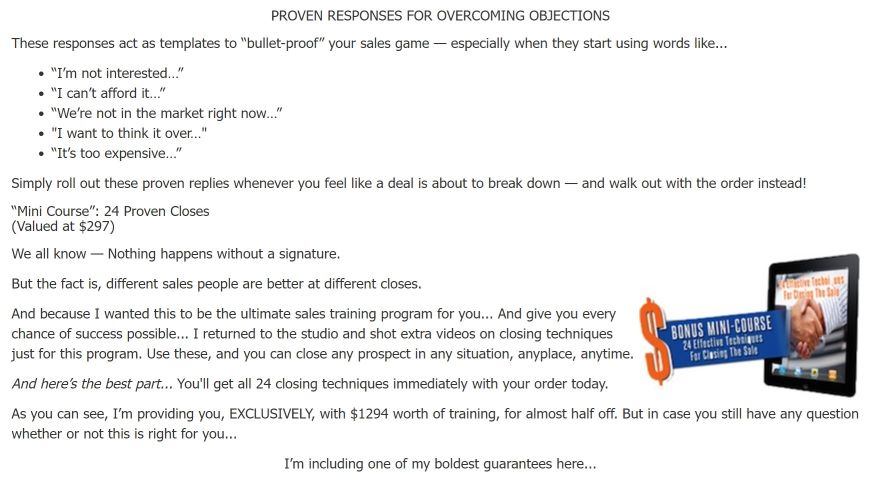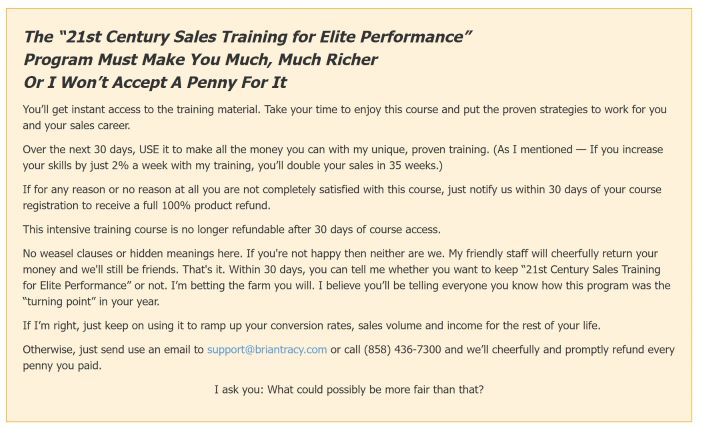I start by setting the stage for mastering the art of the sales pitch. This isn’t just about rattling off product features or pestering prospects until they give in; it’s about understanding the art of persuasion that leads to a mutually beneficial relationship.
If you want to stay ahead of the curve, you’ll need to evolve from the traditional idea of sales to a more modern, consultative approach. That means putting the client’s needs first and aligning your pitch to solve their challenges.
Choose something that resonates with you, your values, and your solution’s strengths. This will lay the groundwork for a sales approach that prioritizes people. Doing so can create a pitch that informs and connects on a human level.
I believe the cornerstone of any successful sales strategy is a deep understanding of the potential client. And that’s precisely what we’re going to explore next. You’ll learn how crucial it is to know who you’re talking to, what they care about, and how your product or service can make a difference in their world.

Understanding Your Audience
I will lay it out straight: knowing your audience isn’t just a good idea; it’s essential for nailing your sales pitch every time. You’ve heard it before, but I’m here to help you grasp why it’s so crucial and how you can effectively tune into your audience’s frequency.
First off, let’s talk about demographics and psychographics. These are the nuts and bolts of your audience’s profile. Demographics tell you who buys your product— age, gender, income level, and education. Psychographics, conversely, clue you into why they’re buying—like personality, values, opinions, and interests.
So why fuss over pain points? Pain points are problems that your potential customers are experiencing. And here’s the kicker: if you can identify and address these problems, your product becomes the hero that saves the day. That’s a connection you want to make time and again.
Now, it’s not all about showcasing features of your product or service. You’ve got to link these features back to the benefits they’ll bring to the customer. That’s a game-changer. It turns a mundane pitch into a persuasive narrative that resonates personally with the audience.
Further Understanding Your Audience
Understanding your audience isn’t just about categorizing them by age or location; it’s about diving deep into their heads. You’ll learn about the significant role of demographic insights and psychographics in crafting your sales pitch. These tools allow you to tailor your message so that it resonates on a personal level.
And when it comes to sales, pain points aren’t just buzzwords; they’re the key to connecting with your customer. These are the issues, needs, or challenges your prospect is looking to solve, and by identifying these pain points, your pitch can go from generic to genuinely compelling. Remember, you don’t just want to push a product; you want to offer a solution that feels almost custom-made.
You turn features into solutions by bridging customer needs with product benefits. This is when the magic happens. Suddenly, it’s not just about what your product can do; it’s about what your product can do for them. This part of the pitch is critical because it translates your product’s abstract benefits into concrete results for your audience.

Building Credibility and Trust
This isn’t just about putting together a great sales pitch; it’s also about fostering an environment of trust with your potential customers. Let’s look at establishing that trust, which is critical to successful sales interaction.
Start by showcasing testimonials and social proof. When potential buyers see that others have had a positive experience with your product or service, it lends immense credibility to your pitch. Share stories and case studies highlighting how your offering has solved problems similar to your current prospect’s.
Being recognized as an expert in your field can significantly enhance trust. You don’t have to have a long list of qualifications, but you should demonstrate expertise and authority in your market niche. This could involve sharing your experiences, insights into industry trends, or data-driven results that your product has achieved.
Consistency across all channels is a must. If your website says one thing and your pitch says another, it will raise red flags. Above all, be honest. If a product isn’t the right fit, say so. This transparent approach might seem like a short-term loss, but it builds a reputation for integrity in the long term.
Remember, a strong foundation of trust sets the stage for everything that follows. You’re paving the way for all those strategic presentation techniques that will turn prospects into customers. You can always adjust your approach but can’t easily rebuild trust once it’s broken.

Presentation Techniques that Convert
You can have a stellar product and a pitch packed with persuasive points, but if your presentation falls flat, so will your sales. I will dive into the winning techniques that make a presentation good, great, and, more importantly, one that converts. Your hands are tools, your voice is an instrument, and your posture is a canvas; It’s all part of the communication tapestry you’re weaving.
Let’s talk storytelling first. This isn’t just about reciting features and benefits; it’s about crafting a narrative that links your product to the listener’s needs. A good story evokes emotions, making your pitch memorable and engaging. Use real-life scenarios where your product solved a critical problem or provided an outstanding benefit to draw your audience in.
Now, onto the non-verbal cues that can speak volumes more than your words. Your body language, eye contact, and breathing can make or break the perceived confidence behind your pitch. Remember to breathe steadily, maintain eye contact, and use purposeful gestures to emphasize key points. This will help build trust and show conviction in what you’re selling.
Lastly, don’t underestimate the power of visuals. Clear and compelling visuals can simplify complex information and create a lasting image in your prospect’s mind. Whether it’s a well-crafted slide deck, a snappy infographic, or a live product demo, visuals are a potent ally in your sales arsenal.
Armed with a strong presentation, your next move is to anticipate and handle objections. This is where the pitch turns into a conversation, and it’s your opportunity to address any reservations head-on, showing that you value and understand your client’s perspective. Remember, every objection is a chance to reinforce how your product can truly benefit your customer.
“No does not mean No! It means you have not given your client enough information to say Yes.” You have not solved their problem yet!

Handling Objections Gracefully
Imagine you’ve laid out your pitch perfectly; it’s clear, compelling, and comprehensive. But then, the potential client raises an objection. Don’t let your confidence waver; this is a positive sign! It means they’re engaged and considering what you’re offering. I’m going to help you turn those objections into opportunities.
Every salesperson will face objections; it’s an inevitable part of the process. But here’s the thing: those objections are often steeped in confusion or a lack of information. They need not mark the end of a sales conversation; instead, they pave the way for deeper dialogue. I’ll discuss strategies for responding to common objections and the mindset you must maintain to do so effectively.
Active listening is your superpower here. When a potential customer objects, listening even more intently is your cue. This isn’t just about waiting for your speech; it’s truly understanding their perspective. Once you’ve identified the genuine concern behind the objection, you’re well-equipped to address it head-on. I’ll share insights on reading between the lines and responding in a way that reassures clients of your value.
Another critical element is maintaining composure. If you react defensively to objections, you risk alienating the customer. Instead, approach each objection with a steady mind and an open heart. Acknowledge their concerns, validate their perspective, and then carefully guide them back to the advantages that your product or service can bring into their lives.
Let’s prepare for a smoother transition to that final step: closing the deal. If you implement the techniques we’re discussing, the close becomes a natural conversation progression. Once objections are addressed, the path clears, and you can guide your client toward making a decision. That’s what we’ll dive into next, embracing effective closing strategies that not only complete the sale but also lay the groundwork for future business.

Closing Strategies for Sales Success
In my opinion, how you close a sale is just as crucial as how you start it. The final moments of your sales pitch can make all the difference, so it’s worth honing a set of strategies that can guide your prospect to a ‘yes.’
Choose something that resonates with you from various psychological closing techniques – the assumptive close, where you act as if the customer has already decided, or the urgency close, where you communicate a time-sensitive offer. Remember, the genuine intent behind your strategy is what matters.
Don’t worry too much about rejection. Every ‘no’ is a step closer to ‘yes’. Ensure that you’re not pressuring the prospect but leading them towards making an informed decision. Your first attempt doesn’t need to be your last; you can always adjust your approach.
Following up is an often overlooked facet of sales, but it’s incredibly important. It’s not just a courtesy; it’s about cementing a relationship that could lead to future sales. Take the time to send a personalized message or call to ensure the customer is satisfied with their decision. This level of care can make you stand out.
I will leave you with this thought: the art of sales is not contained to the pitch alone – it’s an ongoing process of connection, understanding, and growth. Nurture your client relationships as meticulously as you would any other. That’s the strategy I like to leverage for sales success.
Learn more about Howard by Clicking Here!







